
Wine Culture and Information since 2002 - Volume 22
 Wine Culture and Information since 2002 - Volume 22 |
|
Comparing Recioto della ValpolicellaThe great sweet red of Valpolicella protagonist of this month's comparative tasting, a sweet wine of full body and amazing aromas |
|
In past times there was Recioto della Valpolicella, then came Amarone, the robust and renowned red wine, famous in the world for its quality and elegance. The story tells Amarone was born from Recioto, by accident or by the will of a far-sighted viticulturist, a Recioto escaped from the control of events and which is allowed to complete fermentation, therefore becoming dry, that is Amarone, not sweet. Despite the son Amarone surpassed the father in notoriety, Recioto della Valpolicella is however an excellent wine, one of the few sweet red wines of the Italian enological scene. The name Recioto comes from the dialectal Veronese term recie - that is “ears” - with which are called the two upper parts of a grape bunch, ideally positioned like the ears in a head. Recie, because of the position they have in the bunch, receive a higher quantity of sun rays, therefore berries contain a higher quantity of sugar. The protagonist of Recioto della Valpolicella - as well as of Amarone - is Corvina, a red berried grape typical in Valpolicella and capable of making wines of full body. Corvina is not the only grape to be used in the production of Recioto and in the classic composition can be found, although in lesser quantities, the red grapes Rondinella and Molinara. To these grapes can also be added other varieties, of which the most common ones are Corvinone, and marginally, Dindarella, Rossignola and Oseleta, all being red. The grapes are allowed to dry for a period from 90 to 120 days, period during which the grape loses water and the quantity of sugar concentrates. During the drying process, and in favorable conditions, it can also develop Botrytis Cinerea, known as Noble Rot, which will contribute to increase the organoleptic complexity of wine.
|
|
Recioto della Valpolicella is generally produced in wintertime, at the end of the drying of grapes. The fermentation is pretty long and can also last more than 30 days, period during which the must is allowed to macerate with skins, therefore getting color, aromas and body. It will be fermentation to determine if the must will become Recioto or Amarone. When the fermentation goes through the whole process, the result is Amarone, whereas in case some of the sugar is kept, usually not more than 12%, the result is Recioto. The aging of Recioto is done in casks, whose size and characteristic are chosen by the producer according to the style of wine to be made. Traditionally, the aging of Recioto was done in a large cask, whereas today it is not uncommon the use of barrique, as well as it is not rare the use of both types. In fact, some producers prefer to begin the aging in barrique or in cask, and then to transfer Recioto - after some months - to the other type of container.
The tasting of Recioto della Valpolicella is a pretty singular experience for the study of sweet wines. Because of the grapes used and of their content in polyphenols - in particular Corvina - the sensation of sweetness will be followed by an unusual astringent sensation, something generally not found in sweet wines. In our comparative tasting we will evaluate three Recioto wines, aged in variable periods and one of them in barrique. The first wine is Speri's Recioto della Valpolicella Classico La Roggia, the only one being aged in barrique. The other two wines, Tedeschi's Recioto della Valpolicella Classico Capitel Monte Fontana di Tedeschi and Allegrini's Recioto della Valpolicella Classico Giovanni Allegrini, are both aged in cask, although for different periods. In the wines of the tasting, the dominant grape is Corvina, with the exception of Tedeschi's Recioto, in which are also found other varieties, such as Corvinone, Rossignola, Oseleta, Negrara and Dindarella. The three wines will be served at the temperature of 17° C (62° F) and, as usual, poured in three ISO tasting glasses.
|
||||||||
|
The characteristics of Recioto della Valpolicella's appearance are mainly determined by the grape which is found in higher quantity - Corvina - and, in particular, by the production technique. Corvina grape is in fact characterized by a pretty good coloring property, a quality which is also accentuated by the long period of maceration of the skins in the must, with the result of obtaining a wine with a pretty reduced transparency. Recioto della Valpolicella's transparency can in fact be pretty low, sometimes impenetrable to light. Also the color is affected by the qualities of Corvina. In Recioto is generally observed an intense and deep ruby red color, with nuances which in youth can also be purple red, although in most of the cases is ruby red. As the aging develops, a period which in Recioto can also be of tens of years, ruby red is progressively replaced by garnet red, therefore becoming - at the top of aging - brick red. We will begin the first phase of our comparative tasting from Speri's Recioto della Valpolicella Classico La Roggia di Speri. By tilting the glass on a white surface, we will begin by observing the base of the glass, from which will be evaluated the intensity of the color. This Recioto shows an intense ruby red color and a reduced transparency, the same color will also be observed in the nuance, towards the opening of the glass. Let's now pass to the evaluation of the second wine, Tedeschi's Recioto della Valpolicella Classico Capitel Monte Fontana. Also this wine will show an intense ruby red color, and also in the nuance can be seen the same color, whereas it will be noticed a lower transparency, almost impenetrable to light. The color of the third wine - Allegrini's Recioto della Valpolicella Classico Giovanni Allegrini - shows a deep and dark ruby red color, with nuances of the same color. Also in this Recioto the transparency is very low, almost impenetrable to light.
|
|
Just like for appearance, the aromatic qualities of Recioto della Valpolicella are mainly determined by Corvina grape. Also the production technique - and in particular the drying of grapes - contributes to the concentration of aromas, therefore making them richer and more complex. Recioto della Valpolicella is aged in cask - sometimes in barrique as well - a technique which will give the wine its aromatic qualities, therefore enriching it with tertiary aromas. The olfactory evaluation of Recioto allows the discovery of aromas mainly recalling red and black berried fruits - of which, the most typical ones are blackberry, plum and black cherry, also in the form of jams - as well as flowers, of which violet and dried violet are the main representatives. Among other common aromas in Recioto are mentioned chocolate, tobacco, vanilla, cinnamon, licorice and balsamic aromas of menthol and eucalyptus. Let's begin the evaluation of aromas from Speri's Recioto della Valpolicella Classico La Roggia. By holding the glass in vertical position and without swirling - in order to ensure the volatilization of lighter aromatic components only - we will proceed with the first smell which will allow the perception of opening aromas. From the glass will emerge clean, pleasing and pleasing aromas of blackberry, black cherry and dried violet, a very typical opening in Recioto, where blackberry usually plays the role of the protagonist. Let's now proceed with the swirling of the glass - therefore favoring the oxygenation of the wine and the volatilization of heavier aromatic components - and we will then do a second smell. The olfactory profile of this first Recioto will be completed by aromas of blueberry and prune followed by vanilla, tobacco, pink pepper, chocolate and evident hints of menthol and nail polish. Let's now proceed with the evaluation of the second wine of our comparative tasting: Tedeschi's Recioto della Valpolicella Classico Capitel Monte Fontana. By holding the glass in vertical position and without swirling, let's proceed with the evaluation of opening aromas, characterized by blackberry jam, black cherry jam and dried violet, a riper nose than the previous one. The olfactory profile will be completed - after having swirled the glass - by strawberry jam, vanilla, tobacco, cocoa, licorice and hints of nail polish, almond and menthol. The opening of the third wine - Allegrini's Recioto della Valpolicella Classico Giovanni Allegrini - is characterized by intense and clean aromas of blackberry jam, plum jam and dried violet, also in this case, a typical opening in Recioto. The olfactory profile will be then completed by blueberry jam, black cherry jam, tobacco, licorice, vanilla, walnut and chocolate, in which will also emerge pleasing hints of caramel, cinnamon and clover, as well as the balsamic hint of menthol.
|
||||
|
Among sweet wines, the tasting of Recioto della Valpolicella is an unique experience. As it is a red wine, besides the organoleptic qualities typical in sweet wines - in particular sweetness and smoothness - in Recioto della Valpolicella is also found the factor of astringency, given by grape's tannins and by the aging in cask. Because of the long maceration of the skins, astringency in Recioto can sometimes be very evident, a quality which is usually softened after some years of aging in bottle and thanks to the action of alcohol, sugar and roundness. The presence of polyphenols also contributes to give Recioto della Valpolicella a strong and robust body, also in this case, pretty uncommon in sweet wines. As already mentioned, astringency requires the presence of soft organoleptic qualities, which in Recioto is balanced by residual sugar and alcohol, which can also be higher than 15%. We will begin the phase of tasting from Speri's Recioto della Valpolicella Classico La Roggia. Since the first sip, the attack clearly show the typical organoleptic qualities of Recioto: astringency followed by sweetness, all being supported by alcohol. It should also be noticed the excellent correspondence to the nose, in particular the flavors of blackberry, plum and black cherry. The attack of the second wine - Tedeschi's Recioto della Valpolicella Classico Capitel Monte Fontana - is not different from the first one: astringency followed by sweetness and, soon after, the burning sensation of alcohol, very balanced. The same can be perceived in the third wine, Allegrini's Recioto della Valpolicella Classico Giovanni Allegrini: an astringent attack followed by sweetness and then alcohol, very balanced. It should be noticed, in all the three wines, the excellent correspondence to the nose and the pleasing roundness. Finally, another element to be considered is the differences in the use of cask and barrique.
|
|
In the final phase of the tasting, we will evaluate the taste-olfactory persistence of the wines and the sensations left in the mouth. The finish of Speri's Recioto della Valpolicella Classico La Roggia is persistent, leaving in the mouth intense and clean flavors of blackberry, black cherry and plum, very correspondent to the nose and very typical in Recioto. The finish of Tedeschi's Recioto della Valpolicella Classico Capitel Monte Fontana is very persistent, leaving in the mouth intense and clean flavors of blackberry, black cherry and plum to which follows a hint of strawberry. In the finish of the third wine - Allegrini's Recioto della Valpolicella Classico Giovanni Allegrini - can be appreciated a very long persistence, with intense and clean flavors of blackberry jam, black cherry jam and plum jam, more robust than the two previous wines. It should also be evaluated the final sensation of the three wines, in which can be perceived a strong and pleasing sweetness balanced by the astringency and by the full body.
|
Wines of the Month |
|
|
|
Score legend Prices are to be considered as indicative. Prices may vary according to the country or the shop where wines are bought |
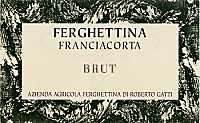
|
|
Franciacorta Brut |
|
| Ferghettina (Lombardy, Italy) | |
| Grapes: Chardonnay (95%), Pinot Noir (5%) | |
| Price: € 19.00 | Score: |
| This Franciacorta Brut shows a pale straw yellow color and nuances of greenish yellow, very transparent, fine and persistent perlage. The nose denotes intense, clean, pleasing and refined aromas which start with hints of apple, banana and pear followed by aromas of bread crust, yeast, praline, hawthorn and grapefruit. The mouth has good correspondence to the nose, an effervescent and crisp attack, however balanced by alcohol, good body, intense flavors, agreeable. The finish is persistent with flavors of apple, banana and grapefruit. This Franciacorta referments in bottle and stays with its yeast for 22 months. | |
| Food Match: Fried fish, Pasta and risotto with fish and crustaceans, Sauteed fish | |
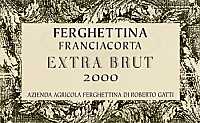
|
|
Franciacorta Extra Brut 2000 |
|
| Ferghettina (Lombardy, Italy) | |
| Grapes: Chardonnay (80%), Pinot Noir (20%) | |
| Price: € 28.00 | Score: |
| This Franciacorta Extra Brut shows a brilliant golden yellow color and nuances of straw yellow, very transparent, fine and persistent perlage. The nose reveals intense, clean, pleasing, refined and elegant aromas which start with hints of banana, peach and hazelnut followed by aromas of bread crust, yeast, acacia, hawthorn, raspberry, apple, tangerine, pear, praline, pink grapefruit and plum. The mouth has excellent correspondence to the nose, an effervescent and crisp attack, however balanced by alcohol, good body, intense flavors, pleasing smoothness. The finish is very persistent with long flavors of banana, peach, hazelnut and tangerine. A well made wine. This Franciacorta Extra Brut ages on its lees for 6 years. | |
| Food Match: Stuffed pasta, Roasted white meat, Roasted fish, Stewed fish | |
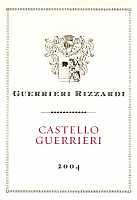
|
|
Castello Guerrieri Rosso 2004 |
|
| Guerrieri Rizzardi (Veneto, Italy) | |
| Grapes: Sangiovese (41%), Corvina (24%), Rondinella (21%), Molinara (9%), Croatina (5%) | |
| Price: € 14.90 | Score: |
| Castello Guerrieri Rosso shows a brilliant ruby red color and nuances of garnet red, moderate transparency. The nose denotes intense, clean, pleasing and refined aromas that start with hints of black cherry, plum and raspberry followed by aromas of blueberry, blackberry, cyclamen, vanilla, tobacco, chocolate and eucalyptus. The mouth has good correspondence to the nose, a tannic attack and pleasing roundness, however balanced by alcohol, good body, intense flavors. The finish is persistent with flavors of plum, blackberry and raspberry. Castello Guerrieri Rosso ages for 24 months in cask. | |
| Food Match: Roasted meat, Broiled meat and barbecue, Stewed meat, Hard cheese | |
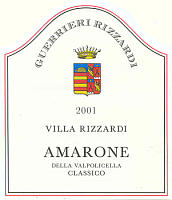
|
|
Amarone della Valpolicella Classico Villa Rizzardi 2003 |
|
| Guerrieri Rizzardi (Veneto, Italy) | |
| Grapes: Rondinella (48%), Corvina (25%), Barbera (10%), Sangiovese (9%), Corvinone (7%) | |
| Price: € 36.50 | Score: |
| This Amarone shows a brilliant ruby red color and nuances of garnet red, moderate transparency. The nose denotes intense, clean, pleasing and refined aromas which start with hints of blackberry, black cherry and plum followed by aromas of violet, blueberry, vanilla, tobacco, chocolate, mace, cinnamon and menthol. The mouth has good correspondence to the nose, a tannic attack and however balanced by alcohol, full body, intense flavors, pleasing roundness. The finish is persistent with flavors of blackberry, black cherry and plum. Amarone della Valpolicella Classico Villa Rizzardi ages for 12 months in barrique, 24 months in cask and about 6 months in bottle. | |
| Food Match: Game, Roasted meat, Braised and stewed meat, Hard cheese | |
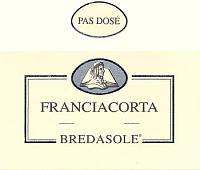
|
|
Franciacorta Pas Dosé |
|
| Bredasole (Lombardy, Italy) | |
| Grapes: Chardonnay (50%), Pinot Nero (30%), Pinot Bianco (20%) | |
| Price: € 11.70 | Score: |
| This Franciacorta shows a brilliant straw yellow color and nuances of straw yellow, very transparent, fine and persistent perlage. The nose denotes intense, clean, pleasing and refined aromas which start with hints of plum, hazelnut and bread crust followed by aromas of banana, yeast, apple, hawthorn and grapefruit. The mouth has good correspondence to the nose, an effervescent and crisp attack, however balanced by alcohol, good body, intense flavors. The finish is persistent with flavors of banana, plum and grapefruit. The base wine used for this Franciacorta ages in steel tanks. | |
| Food Match: Aperitifs, Crustacean appetizers, Pasta and risotto with fish, Sauteed fish | |
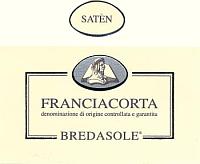
|
|
Franciacorta Satèn |
|
| Bredasole (Lombardy, Italy) | |
| Grapes: Chardonnay | |
| Price: € 11.70 | Score: |
| This Franciacorta Satèn shows a brilliant straw yellow color and nuances of greenish yellow, very transparent, fine and persistent perlage. The nose reveals intense, clean, pleasing and refined aromas that start with hints of banana, bread crust and plum followed by aromas of acacia, yeast, broom, hazelnut, apple, pear, grapefruit and vanilla. The mouth has good correspondence to the nose, an effervescent and crisp attack, however balanced by alcohol, good body, intense flavors, agreeable. The finish is persistent with flavors of banana, plum and hazelnut. The base wine used for this Franciacorta Satèn ages in barrique, referments and ages in bottle on its lees for about three years. | |
| Food Match: Fish and crustacean appetizers, Pasta and risotto with fish and crustaceans, Sauteed fish | |
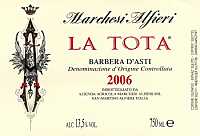
|
|
Barbera d'Asti La Tota 2006 |
|
| Marchesi Alfieri (Piedmont, Italy) | |
| Grapes: Barbera | |
| Price: € 10.50 | Score: |
| Barbera d'Asti La Tota shows an intense ruby red color and nuances of ruby red, moderate transparency. The nose reveals intense, clean, pleasing and refined aromas that start with hints of cherry, blackberry and plum followed by aromas of blueberry, cyclamen, violet and vanilla. The mouth has good correspondence to the nose, a slightly tannic attack and pleasing crispness, however balanced by alcohol, good body, intense flavors. The finish is persistent with flavors of black cherry, plum and blueberry. Barbera d'Asti La Tota ages for about 12 months in cask followed by about 6 months of aging in bottle. | |
| Food Match: Pasta with meat and mushrooms, Sauteed meat, Stewed meat | |
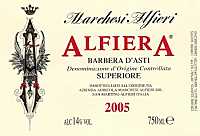
|
|
Barbera d'Asti Superiore Alfiera 2005 |
|
| Marchesi Alfieri (Piedmont, Italy) | |
| Grapes: Barbera | |
| Price: € 21.00 | Score: |
| Barbera d'Asti Superiore Alfiera shows an intense ruby red color and nuances of ruby red, little transparency. The nose reveals intense, clean, pleasing, refined and elegant aromas which start with hints of cherry, plum and violet followed by aromas of blackberry, blueberry, raspberry, vanilla, pink pepper, tobacco, cinnamon, chocolate and menthol. The mouth has excellent correspondence to the nose, a tannic attack and pleasing crispness, however balanced by alcohol, full body, intense flavors, pleasing roundness. The finish is very persistent with long flavors of cherry, plum and blueberry. A well made wine. Barbera d'Asti Superiore Alfiera ages for 12 months in barrique followed by about 8 months of aging in bottle. | |
| Food Match: Game, Roasted meat, Braised and stewed meat, Hard cheese | |
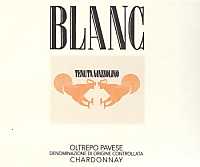
|
|
Oltrepo Pavese Chardonnay Blanc 2005 |
|
| Tenuta Mazzolino (Lombardy, Italy) | |
| Grapes: Chardonnay | |
| Price: € 9.00 | Score: |
| Oltrepo Pavese Chardonnay Blanc shows a pale straw yellow color and nuances of greenish yellow, very transparent. The nose denotes intense, clean, pleasing and refined aromas which start with hints of banana, pear and acacia followed by aromas of apple, plum, peach, melon, vanilla, hawthorn and hazelnut. The mouth has good correspondence to the nose, a crisp attack and however balanced by alcohol, good body, intense flavors, agreeable. The finish is persistent with flavors of banana, pineapple and hazelnut. Oltrepo Pavese Chardonnay Blanc ferments and ages in barrique for 12 months. | |
| Food Match: Stuffed pasta, Roasted white meat, Roasted fish | |
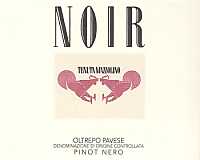
|
|
Oltrepo Pavese Pinot Nero Noir 2003 |
|
| Tenuta Mazzolino (Lombardy, Italy) | |
| Grapes: Pinot Noir | |
| Price: € 19.00 | Score: |
| Oltrepo Pavese Pinot Nero Noir shows a brilliant ruby red color and nuances of garnet red, moderate transparency. The nose reveals intense, clean, pleasing and refined aromas that start with hints of cherry, plum and rose followed by aromas of raspberry, vanilla, tobacco, strawberry, licorice, pink pepper, leather and menthol. The mouth has good correspondence to the nose, a slightly tannic attack and pleasing crispness, however balanced by alcohol, good body, intense flavors. The finish is persistent with flavors of cherry, plum and raspberry. Oltrepo Pavese Pinot Nero Noir ages for about 12 months in barrique. | |
| Food Match: Roasted meat, Broiled meat and barbecue, Stewed meat with mushrooms, Hard cheese | |
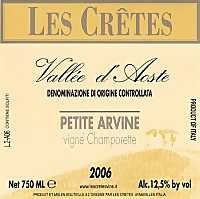
|
|
Valle d'Aosta Fumin Vigne La Tour 2004 |
|
| Les Crêtes (Vallée d'Aoste, Italy) | |
| Grapes: Petite Arvine | |
| Price: € 22.00 | Score: |
| Vallée d'Aoste Fumin Vigne La Tour shows an intense ruby red color and nuances of ruby red, moderate transparency. The nose reveals intense, clean, pleasing and refined aromas which start with hints of strawberry, cherry and raspberry followed by aromas of blackberry, geranium, blueberry, plum, cyclamen, tobacco, pink pepper and vanilla. The mouth has good correspondence to the nose, a slightly tannic attack and pleasing crispness, however balanced by alcohol, good body, intense flavors, agreeable. The finish is persistent with flavors of cherry, strawberry and blueberry. Vallée d'Aoste Fumin Vigne La Tour ages for 12 months in cask. | |
| Food Match: Broiled meat and barbecue, Stewed meat with mushrooms | |
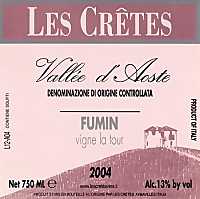
|
|
Valle d'Aosta Petite Arvine Vigne Champorette 2006 |
|
| Les Crêtes (Vallée d'Aoste, Italy) | |
| Grapes: Fumin | |
| Price: € 13.00 | Score: |
| Valle d'Aosta Petite Arvine Vigne Champorette shows a pale straw yellow color and nuances of straw yellow, very transparent. The nose denotes intense, clean, pleasing and refined aromas which start with hints of apple, plum and grapefruit followed by aromas of medlar, pineapple, jasmine, peach, elder, pear and broom. The mouth has good correspondence to the mouth, a crisp attack and however balanced by alcohol, good body, intense flavors, agreeable. The finish is persistent with flavors of apple, plum and grapefruit. This wine ages in steel tanks. | |
| Food Match: Pasta and risotto with fish and crustaceans, Fried fish, Sauteed fish | |
|
|
|
Adarmando 2006 |
|
| Tabarrini (Umbria, Italy) | |
| Grapes: Trebbiano Spoletino | |
| Price: € 14.00 | Score: |
| Adarmando shows a pale golden yellow color and nuances of straw yellow, very transparent. The nose reveals intense, clean, pleasing and refined aromas that start with hints of apple, medlar and plum followed by aromas of peach, pineapple, hawthorn, broom, honey, pear, hazelnut and hints of mineral. The mouth has good correspondence to the nose, a crisp attack and however balanced by alcohol, good body, intense flavors, pleasing roundness. The finish is persistent with flavors of apple, peach and hazelnut. Adarmando ages for at least 4 months in steel tanks followed by 3 months of aging in bottle. | |
| Food Match: Pasta and risotto with mushrooms and crustaceans, Sauteed white meat, Sauteed fish | |

|
|
Sagrantino di Montefalco Colle Grimaldesco 2004 |
|
| Tabarrini (Umbria, Italy) | |
| Grapes: Sagrantino | |
| Price: € 25,00 | Score: |
| The wine shows a deep ruby red color and nuances of ruby red, little transparency. The nose reveals intense, clean, pleasing, refined and elegant aromas which start with hints of black cherry, plum and blackberry followed by aromas of violet, black currant, vanilla, blueberry, tobacco, cocoa, mace, pink pepper and menthol. The mouth has excellent correspondence to the nose, a tannic attack and however balanced by alcohol, full body, intense flavors. The finish is very persistent with long flavors of blackberry, black cherry and plum. A well made wine. Sagrantino di Montefalco Colle Grimaldesco ages for 30 months in cask followed by 6 months of aging in bottle. | |
| Food Match: Game, Roasted meat, Stewed and braised meat, Hard cheese | |
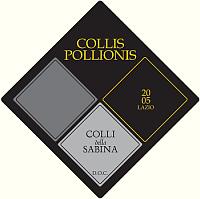
|
|
Colli della Sabina Bianco Collis Pollionis 2005 |
|
| Tenuta Santa Lucia (Latium, Italy) | |
| Grapes: Malvasia Bianca, Falanghina, Sauvignon Blanc | |
| Price: € 12.00 | Score: |
| This wine shows an intense greenish yellow color and nuances of greenish yellow, very transparent. The nose denotes intense, clean and pleasing aromas that start with hints of apple, plum and pear followed by aromas of almond, pineapple and hawthorn. The mouth has good correspondence to the nose, a crisp attack and however balanced by alcohol, good body, intense flavors, pleasing roundness. The finish is persistent with flavors of apple and plum. Colli della Sabina Bianco Collis Pollionis ages in steel tanks. | |
| Food Match: Pasta and risotto with fish and vegetables, Sauteed meat, Sauteed fish | |
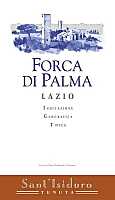
|
|
Forca di Palma 2006 |
|
| Sant'Isidoro (Latium, Italy) | |
| Grapes: Chardonnay (70%), Trebbiano Toscano (30%) | |
| Price: € 8.00 | Score: |
| Forca di Palma shows an intense greenish yellow color and nuances of greenish yellow, very transparent. The nose denotes intense, clean and pleasing aromas that start with hints of apple, pear and acacia followed by aromas of banana, peach and plum. The mouth has good correspondence to the nose, a crisp attack and however balanced by alcohol, good body, intense flavors. The finish is persistent with flavors of apple, pear and plum. Forca di Palma ages in steel tanks. | |
| Food Match: Crustaceans and fish appetizers, Vegetable soups, Risotto with Crustaceans | |
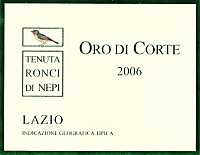
|
|
Oro di Corte 2006 |
|
| Tenuta Ronci di Nepi (Latium, Italy) | |
| Grapes: Chardonnay | |
| Price: € 9.00 | Score: |
| The wine shows a brilliant golden yellow color and nuances of straw yellow, very transparent. The nose denotes intense, clean and pleasing aromas that start with hints of apple, plum and banana followed by aromas of pear, acacia and hawthorn. The mouth has good correspondence to the nose, a crisp attack and however balanced by alcohol, good body, intense flavors, pleasing roundness. The finish is persistent with flavors of apple, plum and banana. Oro di Corte ages for 5 months in steel tanks. | |
| Food Match: Pasta with fish, Sauteed fish, Sauteed white meat | |
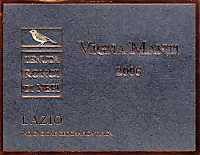
|
|
Vigna Manti 2006 |
|
| Tenuta Ronci di Nepi (Latium, Italy) | |
| Grapes: Chardonnay | |
| Price: € 18.00 | Score: |
| Vigna Manti shows an intense straw yellow color and nuances of golden yellow, very transparent. The nose denotes intense, clean, pleasing and refined aromas that start with hints of banana, apple and pear followed by aromas of plum, vanilla, hazelnut and honey. The mouth has good correspondence to the nose, a crisp attack and however balanced by alcohol, good body, intense flavors, pleasing smoothness. The finish is persistent with flavors of banana, apple and honey. Vigna Manti ages for 6 months in barrique. | |
| Food Match: Stuffed pasta, Roasted fish, Roasted white meat | |
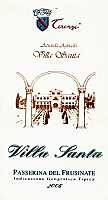
|
|
Villa Santa 2006 |
|
| Terenzi (Latium, Italy) | |
| Grapes: Passerina | |
| Price: € 6.00 | Score: |
| Villa Santa shows an intense greenish yellow color and nuances of greenish yellow, very transparent. The nose denotes intense, clean and pleasing aromas that start with hints of apple, pear and broom followed by aromas of hawthorn and plum. The mouth has good correspondence to the nose, a crisp attack and however balanced by alcohol, good body, intense flavors. The finish is pretty persistent with flavors of apple and plum. Villa Santa ages in steel tanks. | |
| Food Match: Vegetable appetizers, Risotto with Vegetables, Eggs | |
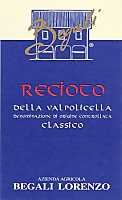
|
|
Recioto della Valpolicella Classico 2004 |
|
| Begali (Veneto, Italy) | |
| Grapes: Corvina (35%), Rondinella (30%) | |
| Price: € 17.00 - 50cl | Score: |
| This Recioto della Valpolicella shows a deep ruby red color and nuances of purple red, impenetrable to light. The nose reveals intense, clean, pleasing and refined aromas which start with hints of blackberry, black cherry and plum followed by aromas of dried violet, blueberry, vanilla, tobacco, chocolate, cinnamon, menthol and nail polish. The mouth has good correspondence to the nose, a sweet and tannic attack, however balanced by alcohol, full body, intense flavors, pleasing roundness. The finish is persistent with flavors of blackberry, black cherry and plum. This Recioto della Valpolicella ages for 12 months in cask followed by at least 6 months of aging in bottle. | |
| Food Match: Confectionery, Hard cheese, Jam tarts | |
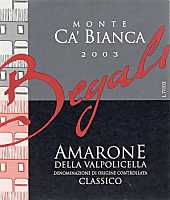
|
|
Amarone della Valpolicella Classico Monte Ca' Bianca 2003 |
|
| Begali (Veneto, Italy) | |
| Grapes: Corvina (40%), Corvinone (35%), Rondinella (20%), Oseleta (5%) | |
| Price: € 30.00 | Score: |
| Amarone della Valpolicella Classico Monte Ca' Bianca shows an intense ruby red color and nuances of garnet red, little transparency. The nose denotes intense, clean, pleasing, refined and elegant aromas that start with hints of blackberry, plum and black cherry followed by aromas of violet, vanilla, raspberry, blueberry, tobacco, chocolate, cinnamon, mace and menthol. The mouth has good correspondence to the nose, a tannic attack and however balanced by alcohol, full body, intense flavors, agreeable. The finish is persistent with flavors of blackberry, plum and black cherry. A well made wine. Amarone della Valpolicella Classico Monte Ca' Bianca ages for about 4 years in cask followed by at least 8 months of aging in bottle. | |
| Food Match: Game, Roasted meat, Braised and stewed meat, Hard cheese | |
|
||||||||
|
DiWineTaste Polls
|
| |||||||
Privacy Policy | |||||||


| Copyright © 2002-2024 Antonello Biancalana, DiWineTaste - All rights reserved |
| All rights reserved under international copyright conventions. No part of this publication and of this WEB site may be
reproduced or utilized in any form or by any means, electronic or mechanical, without permission in writing from DiWineTaste. |